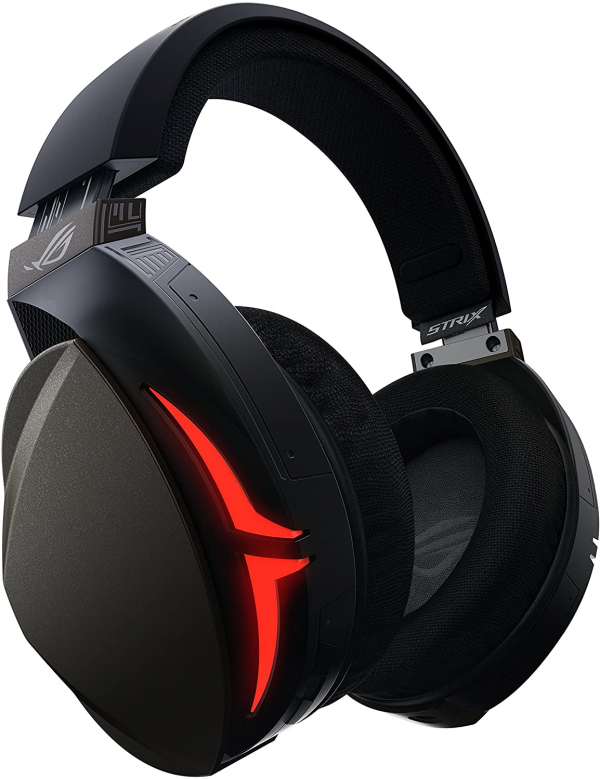Asus ROG
Asus ROG Strix Fusion 500: gaming headphones that forget the basics
Aprox. 328€ - see price -
Asus' new flagship gaming headset, the ROG Strix Fusion 500 displays among its selling points not only the sadly unavoidable RGB lights, but also the promise of quality sound, which would be guaranteed by the presence of a DAC / ESS Saber 9018/9601 amplifier , Hi-Res Audio certification and virtual 7.1 processing. Very good intentions ... which are unfortunately not carried out at all.
Our review
Ergonomics
Overall, very classic construction, the Fusion 500 is not luxurious but still produces a pretty good impression at first contact. If it is mainly made of plastic, the hinges and the arch benefit from an aluminum frame which contributes to the impression of very correct solidity that the helmet provides. The roll bar is also very flexible, and should therefore not be particularly prone to breakage.
The comfort is also correct, but not flawless. The ear cups are certainly very wide but not very deep: for people with big ears, the flags can be in contact with the loudspeaker grille, which can cause a little pain after a few tens of minutes. In addition, very large heads can also be hampered by the lack of articulation of the atria on the horizontal axis, inducing a high pressure on the base of the jaw.
The Fusion 500 is supplied with two pairs of pads, one in leather, the other in fabric. The leather pads are very pleasant to the touch, but can keep the ears a little too warm for the taste of some. The fabric ear cups do not have this defect, but they are a bit rough, so less pleasant to wear for very long sessions.
The only connection available is a micro-USB port which allows you to connect the headphones to a computer or a PlayStation 4 console. No analog connection is possible - too bad for the versatility. Asus has chosen to provide a braided USB cable with its headphones, which turns out to be a bad decision, because said cable causes very audible solid conduction: every tiny friction on a garment or on the desk becomes particularly irritating. Fortunately it is possible to get rid of this problem simply by using a standard plastic cable.
In addition to its USB connector, the Fusion 500 also has Bluetooth connectivity ... but this is exclusively dedicated to the Aura Sync functionality, which offers to synchronize RGB light effects between a maximum of three headsets. Big deal. Since we are talking about it, these light effects are controlled via the Aura application (available on Windows, iOS and Android), an application that has no other use. Fortunately, it is possible to deactivate them completely.
A single mechanical button is present on the helmet, controlling the activation of virtual 7.1. The rest of the commands and grouped on a touch panel on the back of the left atrium, using the principle popularized for example by the 1000X range from Sony. Short press to pause / play, swipe forward or backward for navigation between tracks, swipe up or down to adjust the volume: the recognized gestures are very classic and their intuitiveness is is more to demonstrate. This interface would however have been better developed if the recognition had been a little more reliable. As for the fact of having dressed this touch panel with a shiny surface so easily hanging fingerprints, it will cause cold sweats to lovers of cleanliness ...

Audio
Large 50mm transducers, DAC and high-end integrated amplifier, Hi-Res Audio certification: Asus has no shortage of arguments to tout the audio merits of its headphones. The recall to reality is all the more painful.
Is it really necessary to dwell on this disastrous frequency response? It is hard to imagine less control. Between the abyssal hollow at 300 Hz which deprives the midrange sounds of their fundamental, therefore of all their presence, the one at 4 kHz which destroys the feeling of space and deprives the sound of all its energy, the irregularity of the treble extremes which makes the whole all the same aggressive and particularly quick to generate hearing fatigue ... It is an understatement to say that all this is not convincing.
More generally, the lack of precision in the acoustic behavior of the membranes is gross. The bass is boomy and sparse, failing to give the slightest solid foundation to the sound message. The timbres are false, and human voices in particular are reproduced without an ounce of naturalness. The dynamics are weak, the reactivity on the transients is poor over the whole spectrum and the sound is therefore completely flat. The stereophony is narrow, and the room effects distorted by the irregularity of the treble, which prevents the appearance of any depth in the sound scene.
In this respect, moreover, the virtual "7.1" spatialization proposed by the helmet is irrelevant. It is heavily handicapped not only by the imprecision of the headphones, but also quite simply that it is not a real 7.1: the headphones are seen by the PC only as a stereo device, and it is so on a two-channel signal that the headset applies its processing. In fact, it is absolutely not possible to distinguish a sound coming from the front from a sound coming from the rear.
In short, at almost all levels, the Fusion 500 delivers very insufficient sound performance, completely disconnected from its ambitions.

Microphone
The Fusion 500's microphone has a small channel in which it can be completely retracted when it is not in use. As usual now, it closes automatically when it goes up and opens when it goes down. The pole is not extendable, but its size should be suitable for almost all users.
The capture proposed by the microphone is correct, nothing more. It lacks bass as much as treble so that the restitution of the voice is perfectly natural, but at least intelligibility suffers from no problem. The microphone is also not very directive and quite sensitive to outside noise; coupled with the little insulation provided by the earpieces, this completes making this Fusion 500 a headset particularly unsuitable for playing in noisy environments.

Conclusion
No need to dwell on the comfort, design or functionality of this Strix Fusion 500: its sound performance, which should have been one of its strong points, is actually an insurmountable weak point. No transparency, dynamic at half mast, large deficit of precision ... It is not difficult to find much better, for much less.

